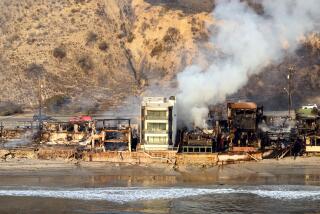Ideal Home Turns Into a Nightmare : Building: Soon after its sale for $530,000, the Spanish-style house began splitting in two.
- Share via
DIAMOND BAR — Three years ago, Josef and Kanda Farrar decided to take the plunge: After living for eight years in a modest blue-collar neighborhood in Monrovia, they poured their life savings into a $530,000 house in the rolling hills of Diamond Bar.
It was their dream home. Within a year, it would become the house from hell.
The split-level house is nestled in a gated, exclusive hillside enclave called the Country Estates. “We saved for 20 years to get here,” said Josef Farrar, 39, a commercial real estate broker in Los Angeles.
The 2,900-square-foot, Spanish-style home on 1.2 acres, was spacious enough for their growing family and three dogs, and a serene hideaway with enough land to build a swimming pool and stables for their two horses.
“We absolutely fell in love with the area and the house,” said Kanda Farrar, 36. But eight months after the family moved in, she noticed something was amiss while vacuuming the family room. There was a ridge in the carpeting, as if the underlying concrete were buckling and separating.
Soon they began noticing growing cracks in the upstairs walls. Josef Farrar’s sleep was interrupted by “creaking, popping noises” too loud and insistent to be the routine settling of a 10-year-old house.
An architect hired to design an upstairs addition took one look at the cracks and suggested that the Farrars have the problem investigated by structural engineers.
What engineers found was that the house was splitting in two, with one section sinking down a shallow hillside. An abnormal leakage of water from the septic tank system was blamed for softening the graded earth that supported the house.
Within months, serious problems began to surface. Gaps appeared along a front-yard cement walkway and an adjacent retaining wall attached to the house. The gas company’s standing utility box along the side of the house began to be lifted off its mooring, creating the potential for a broken gas line.
Then, “the house was sinking so fast that the septic tank separated,” Kanda Farrar said. Despite repeated visits from plumbers to drain and repair the system, the problem only grew worse. Raw sewage began backing up in the downstairs shower and flowing into the family room, contaminating the carpet.
“Our youngest son, Jonathan, was just in the crawling stage,” Josef Farrar said. “We were concerned about his safety. With raw sewage, you risk exposure to hepatitis.” One night the stench was so fierce that the couple roused their two sons and fled to a neighbor’s home.
“The entire lower level was filled with raw sewage,” Kanda Farrar said. During this period, the Farrars said they spent as much as $600 a week for plumbers and carpet cleaners.
“It just happened again and again,” Josef Farrar said. Meanwhile, cracks in the outside walkway and in the family room floor grew ominously larger, reaching a width of two to three inches.
Friends began to hedge on dinner invitations. “Everybody was afraid the house was going to fall down,” Kanda Farrar said. Finally, the septic tank collapsed again in October. “We couldn’t run any water or flush the toilet,” she said. “We lived next door with our neighbors for two days, and then moved out.”
They moved to a rented four-bedroom house in San Gabriel, where they remain. Since abandoning their home, haggling with the insurance company and the bank that holds the mortgage has become the Farrars’ primary focus.
West American Insurance Co. in Anaheim denied the Farrars’ claim for loss of the house but has been paying for their rental house during the investigation. Lawyers for the Farrars and the insurance company say negotiations to reach a settlement are continuing.
The patching of a large crack in the utility room foundation, hidden beneath linoleum tiles, points to a cover-up of structural deficiencies, said Jeffrey Metzger, the Farrars’ lawyer. Attempts to locate the home’s previous owner have failed. “They bought a house that may have been in defective condition, and no one told them about it,” Metzger said.
Meanwhile, the Farrars stopped making mortgage payments last summer. As a result, HomeFed Bank in San Diego is pressing for foreclosure, citing the length and uncertainty of the Farrars’ negotiations with West American.
In addition, city officials have condemned the house. Notices were posted on all entrances to warn of potential hazards.
Dennis Tarango, a Diamond Bar building official, said the Farrars have until February to either demolish the structure or submit plans to rebuild it. If they don’t, the matter could be directed to the district attorney’s office, he said.
Tarango said the city has no reports of similar damage to any other homes in Diamond Bar but added that the soil in the region is not the best base for construction. He said routine inspections of other houses nearby turned up no evidence of obvious structural failure.
The Farrars, who have submitted various proposals to the bank to delay foreclosure, say it would cost $600,000 to repair the home, about $70,000 more than they paid for it. Their other option would be to reach a settlement with the bank and the insurance company that would allow them to be rid of the property with what they say is an acceptable loss of about $100,000.
“We just want to get this thing behind us and move on,” Josef Farrar said.
“Our whole life is on hold,” his wife said. “It’s scary to think what could happen to us in a situation that is so totally out of our control.”
More to Read
Inside the business of entertainment
The Wide Shot brings you news, analysis and insights on everything from streaming wars to production — and what it all means for the future.
You may occasionally receive promotional content from the Los Angeles Times.










